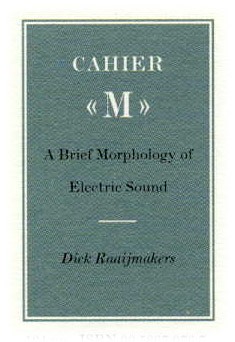Dick Raaijmakers: Cahier-M: A Brief Morphology of Electric Sound (2000)
Filed under book | Tags: · acoustics, architecture, electronic music, music, music theory, sound

Cahier-M is about the morphology of electric sound. This inherently single-layered type of sound is discussed in the light of ‘neo-plastic’ music as suggested by the painter Piet Mondriaan in the 1920’s. He advocated a kind of music that consisted of single-layered, ‘single-colour’ electric sounds.
Furthermore, Cahier-M devotes ample attention to the morphological relationship between the typically uniform nature of electric sound and the multi-layered sound structures used by post-WWII serial composers. The discussion of this subject also covers layering (photo)graphic images as practised by the French physiologist E.J. Marey at the end of the 19th century, flipping monadic sound aggregates as practised by Karel Goeyvaerts since 1952, the application of so-called ‘horizontal arpeggios’ by Pierre Boulez around 1980, and the introduction of ‘liquid forms’ in contemporary architecture.
These aspects are illustrated based on a still valid morphological analysis of sound conducted by the author between 1963 and 1967.
Cahier-M comprises four chapters: ‘Invented Sound’, ‘Diagonal Sound’, ‘Composed Sound’ and ‘Spatial Sound’.
Publisher Leuven University Press, 2000
Volume 3 of Collected Writings of the Orpheus Institute
ISBN 9058670767
123 pages
See also Raaijmakers’ Method (1985) and The Destructive Character (1992).
Comment (0)Peter J Schmelz: Such Freedom, If Only Musical: Unofficial Soviet Music During the Thaw (2009)
Filed under book | Tags: · 1950s, 1960s, 1990s, classical music, cold war, composing, music, music history, music theory, soviet union

Following Stalin’s death in 1953, during the period now known as the Thaw, Nikita Khrushchev opened up greater freedoms in cultural and intellectual life. A broad group of intellectuals and artists in Soviet Russia were able to take advantage of this, and in no realm of the arts was this perhaps more true than in music. Students at Soviet conservatories were at last able to use various channels–many of questionable legality–to acquire and hear music that had previously been forbidden, and visiting performers and composers brought young Soviets new sounds and new compositions. In the 1960s, composers such as Andrey Volkonsky, Edison Denisov, Alfred Schnittke, Arvo Pärt, Sofia Gubaidulina, and Valentin Silvestrov experimented with a wide variety of then new and unfamiliar techniques ranging from serialism to aleatory devices, and audiences eager to escape the music of predictable sameness typical to socialist realism were attracted to performances of their new and unfamiliar creations.
This “unofficial” music by young Soviet composers inhabited the gray space between legal and illegal. Such Freedom, If Only Musical traces the changing compositional styles and politically charged reception of this music, and brings to life the paradoxical freedoms and sense of resistance or opposition that it suggested to Soviet listeners. Author Peter J. Schmelz draws upon interviews conducted with many of the most important composers and performers of the musical Thaw, and supplements this first-hand testimony with careful archival research and detailed musical analyses. The first book to explore this period in detail, Such Freedom, If Only Musical will appeal to musicologists and theorists interested in post-war arts movements, the Cold War, and Soviet music, as well as historians of Russian culture and society.
Publisher Oxford University Press, 2009
ISBN 0195341937, 9780195341935
408 pages
review (Pauline Fairclough, Notes)
review (Kiril Tomoff, The American Historical Review)
review (Solomon Volkov, Radio Svoboda, in Russian)
Robert Fink: Repeating Ourselves: American Minimal Music As Cultural Practice (2005)
Filed under book | Tags: · minimal music, minimalism, music, music history, music theory

Where did musical minimalism come from—and what does it mean? In this significant revisionist account of minimalist music, Robert Fink connects repetitive music to the postwar evolution of an American mass consumer society. Abandoning the ingrained formalism of minimalist aesthetics, Repeating Ourselves considers the cultural significance of American repetitive music exemplified by composers such as Terry Riley, Steve Reich, and Philip Glass. Fink juxtaposes repetitive minimal music with 1970s disco; assesses it in relation to the selling structure of mass-media advertising campaigns; traces it back to the innovations in hi-fi technology that turned baroque concertos into ambient “easy listening”; and appraises its meditative kinship to the spiritual path of musical mastery offered by Japan’s Suzuki Method of Talent Education.
Publisher University of California Press, 2005
Roth Family Foundation: Music in America imprint
ISBN 0520245504, 9780520245501
280 pages
interview with the author (Molly Sheridan, NewMusicBox)
Comment (1)
